by Briscoe White | Nov 7, 2011 | Miscellaneous |

When many people envision their garden, they feel the need to choose between fashion and function — Flowers or Herbs. Yet, little do they know, that the two can be combined to enjoy the best of both worlds. We tend to forget to appreciate herbs in our garden, focusing mainly on the end product- their flavor. So what does an herb offer for your landscape?
Contrast
Herbs add depth and contrast to your existing flower gardens, by offering a myriad of verdant colors that enhance the color of your buds and blooms. By filling space around, between, and under your existing flowers, herbs allow the blooming colors to seem more vibrant. Essentially, they frame your flowers without detracting from their beauty. The many textures of their varying foliage also make your garden more interesting, and you can alternate from glossy, dark green Basils such as the Italian Large Leaf Basil, to the variegated leaves of the low-growing, Pineapple Mint. Wonderful Golden Variegated and Silver Edged Thymes, Tricolored Sage and Amethyst Basil are just a few of the naturally stunning plants that add can compliment your flower garden, with little effort to maintain.
Color
Many herbs themselves have beautiful blooms that often go overlooked or undesired if grown solely for their culinary benefits. Once an herb beings to bloom and goes to bolt, the flavor profile may change, so culinary herb gardeners tend to prune the flowering tops of these plants to preserve the herb’s flavor intensity. If left to flower, most herbs display beautiful spires, clusters and sprigs of color that will continue all summer long. Pineapple Sage, Rosemary, Basils and Fennel are just a handful of culinary herbs that may be best left un-snipped to allow their blooms to attract wildlife and lend beauty to your landscape. Other herbs not traditionally used to cook with that provide an array of color are Clary Sage, Joe Pye Weed, Sweet Woodruff and Rue.
Naturally Beneficial
Many herbs have natural insect and pest repelling properties that will actually help protect your neighboring flowers from outside attacks from unwanted visitors. Incorporating your landscape with these non toxic defenders will ensure a healthier garden and less stress for you, too. Herbs like Bergamot and Chives which will deter deer and Tansy which repels Japanese Beetles, have wonderful blooms that will look great while safeguarding your other plants. Not only will these flowering herbs keep pests out, but their sweet scents will help entice valuable pollinators like hummingbirds, bees and butterflies to encourage the pollination and growth of your garden. Many herbs are havens for very specific types of butterflies, such as the Monarch Butterfly, which tends to favor Fennel flowers.
Planning Is Key
Gardening with herbs does not have to be complicated; with a bit of planning and a little imagination, you can either use herbs to transform an existing bed or start completely from scratch. In either case, it is important for you to do some preliminary groundwork. Determining the purpose for your garden is one of the first steps to enjoying it. Having an end use in mind will help dictate what and how you plant. For example, a kitchen garden might be best planted close to your back door for easy access to fresh herbs while you cook. You want those fresh flavors close at hand when you need a sprig of Tarragon and don’t want to trek across your yard.
What space do you have to work with? Remember that your plants will mature quickly and flush out beautifully, so space needs to be a consideration when planning. It wouldn’t hurt to consult with a california lawn care specialist to get a different perspective on how you might tackle the job. I’ve made the mistake of planting starter plants too closely and they end up choking each other out. Save yourself the future headache and allow at least three to eight feet for a perennial herb and about one to three feet for an annual. This will ensure that your plants have plenty of space to stretch out and grow. The height and spread of each plant, are also important in terms of light. Make sure to plant your more dramatic, upright herbs closer to the back, leaving ample space for low lying, creeping herbs like Thyme closer to the front where they may still get plenty of light. Your herbs will need at least six hours of direct light a day, and if you invest in perennial plants, you’ll have to plan for shifting sunlight as the days get shorter, moving into the Fall season.
The soil that you start your garden in, is just as important as the amount of light the area gets. Herbs need well draining soil, and some, like Lavenders are particularly fussy about “wet feet”. Test your soil and plant accordingly. You may even want to add sand or organic compost to different parts of your garden, to cater to the specific needs of certain plants. That being said, study up on each plant. Even the “usual suspects”. Knowing each plant’s specific needs will allow you to provide for them and diagnose any unforeseen issues that may arise. (It’s also a good way to make sure you’re not planting unwanted plants like invasive species.)
It helps to plot out your garden on paper first, before you break ground. This is a wonderful way to spend your cold winter nights. Just curl up with some graphing paper and a pencil, with a cup of hot chocolate begin to dream and scheme about the spring. Thinking ahead will keep you company through the cold and you’ll be ready to get started as soon as the ground thaws.This will save you a lot of trouble and it will ensure that each plant gets the proper attention and resources that it needs.
It’s time to reinvent the way we look at growing herbs and remember to choose them for their colors, textures and blooms. Many herbs are perennial and will remain long after your flowers fade. Most need little water and don’t prefer to be fertilized, making them very simple ways to round out your landscape for a more interesting look. So this spring, as you’re buying plants and making plans for your yard, consider adding herbs not just for their flavor, but for the beauty the can bring to your favorite spaces.
by Briscoe White | Nov 3, 2011 | Miscellaneous |
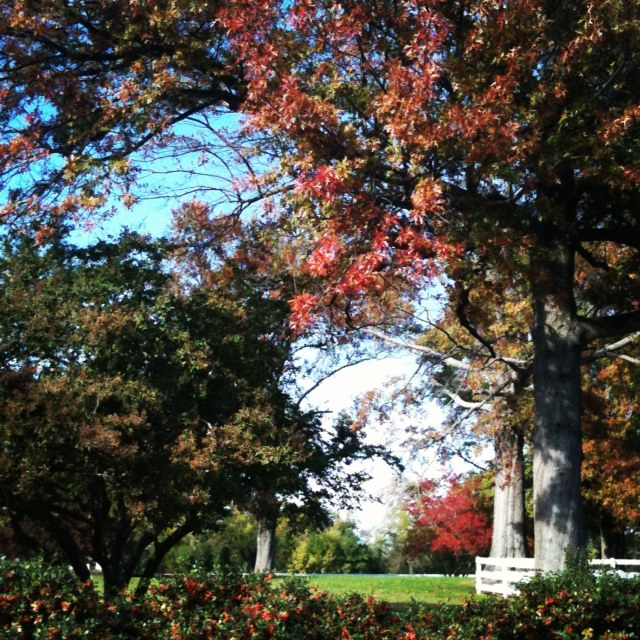
Fall has arrived at our farm! We’re just beginning November and soon the mad dash from holiday to holiday will ensue. We took this brief opportunity to get outside and enjoy the colors as the creep into the tree line.
Don’t forget to stock up on fresh culinary herbs for this holiday season, before it’s too late! We’ll continue our Fall Clearance Sale through Sunday, November 6th, where all of our 4″ herbs and flowers are only $3.00. After that, you’ll have to order early and wait til things thaw out in the spring!
In the meantime, here are a few reminders for Fall gardening:
* Don’t forget to mulch!
* This is the prime time to plant perennials and spring bulbs, so get digging!
* Time to bring in your tender perennials. Transplant into clean pots using new soil and don’t forget- they need at least 6 hours of direct sunlight to stay happy indoors.
* Some places have already seen snow this year (yikes!) so don’t forget to refill your bird feeders to make sure our feathered friends have plenty to eat.
* Deadhead perennials and remove any dead or diseased foliage.
* Start planning a winter or indoor garden.
by Briscoe White | Oct 31, 2011 | Miscellaneous |

It’s Halloween and on this macabre Monday we have a few harrowing tales about some of your most beloved plants! Many people are led to believe that the plants they’ve come to know in their gardens and greenhouses are innocent, unassuming herbs and flowers, but some of these commonplace plants have wicked reputations throughout history.
Many common herbs found in your own kitchen actually have various superstitions related to them. For instance, in the Middle Ages, people would sprinkle Rosemary under their pillows and mattresses to prevent nightmares and evil spirits from haunting their dreams.
You may be used to finding Fennel in your sausages, but people once placed Fennel seeds in the keyholes of their doors to keep ghosts from sneaking in. They also hung Fennel in their doorways during Midsummer Eve to evil spirits away from their homes, as this was the night they were thought to come back to earth. (For many cultures that still celebrate the Summer Solstice or Midsummer Eve, herbs are still very significant.)
Many people still use Cleansing Sticks to purify their new homes, apartments and offices, but did you know that this practice actually dates back to Native American prayer ceremonies? Drying White Sage (some people also use Garden Sage) and then rolling it and wrapping it tightly into a small, compact bundle, allows the sage to smolder instead of burn up in a flash. The bundle is then carried from room to room, allowing the smoke to waft throughout the dwelling to keep negative energy and evil spirits away.
Achillea and Rue were both sprinkled around windows and doorways to keep ghosts, witches and evil spirits from entering a home. Rue, also known in traditional herbalism as “Witchbane” was also carried in bundles in peoples’ pockets to ward off witches. Now, witches have magic on their side, and after making a book of shadows, you’d think they’d have documented all of their deepest darkest secrets to find a way to counteract this practice (in the safest way possible of course). Or maybe they didn’t. I don’t know enough about witchcraft to make an accurate judgment, but people seemed to believe this idea. It was also thought that both Achillea (Yarrow) and Rue would protect a person from hexes and the “evil eye”. Achillea was also hung over babies’ cribs to protect their souls from witches.
These are just a few of the historically “haunted” herbs that you can commonly find in your garden or pantry. Most medicinal herbs were used for protection from plagues, hexes and witches…what people didn’t realize was that in most cases, it was the antiseptic, anti bacterial or anti fungal properties of the plant that protected them from the supposed hauntings and conjured plagues.
For a great book on herbal folklore and poisonous plants from A-Z, check out Amy Stewart’s book Wicked Plants.
by Herb Exchange | Oct 5, 2011 | Miscellaneous |
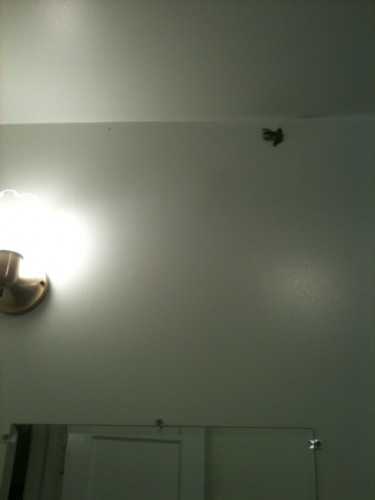
There was some commotion this morning as our Marketing Director, Caroline, found that she wasn’t alone in the bathroom…
While October is one of my favorite months, because of the feeling of mystery and surprise in the air, I wasn’t quite expecting the fright I found in our office bathroom this morning. Don’t get me wrong–I don’t scare easily, I mean, I LOVE horror movies and Halloween is my favorite holiday. I was even raised in the country, so I’m used to creepy, crawly things. But getting caught off guard in the bathroom by an unidentified jumping object, BEFORE I’ve had my morning coffee…well, that would be enough to make anyone jump.
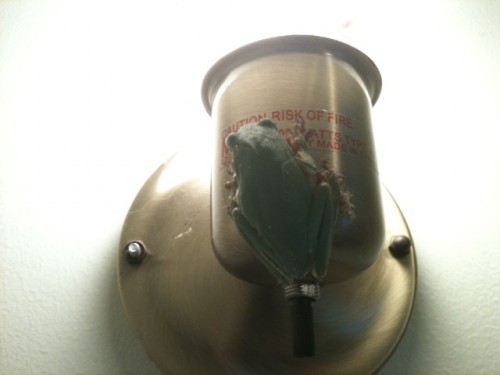
I was minding my business and fixing my hair, when I saw something leap from the wall to the light fixture, inches from face. Immediately thinking it was a monster, (maybe I should lay off the scary movies!) I jumped back in surprise. As it turns out, it wasn’t some brain-eating, blood sucking creature from beyond, but a wayward frog who’d found his way into our office.
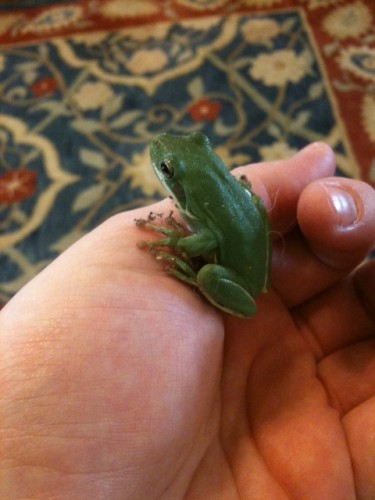
After chasing him around the office for a bit, trying hopelessly to catch him (they’re a lot quicker than they look!), I finally got a grasp on this little green man. He tried to escape a few times, even once jumping into my hair (which elicited another surprised scream), but eventually, I was able to convince him that the outside was a lot nicer. I took him out to our porch and he immediately made a jump for our hydrangea bush where he’ll be a lot happier and we won’t be looking over our shoulder for little green monsters in our office.
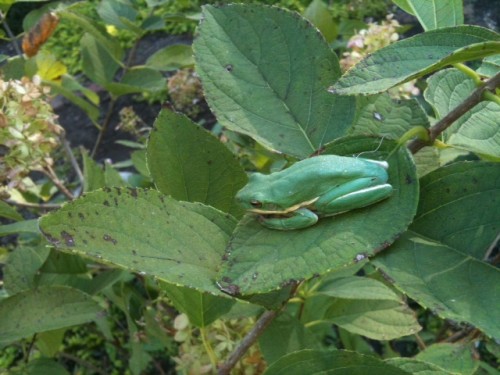
by Briscoe White | Oct 4, 2011 | Miscellaneous |
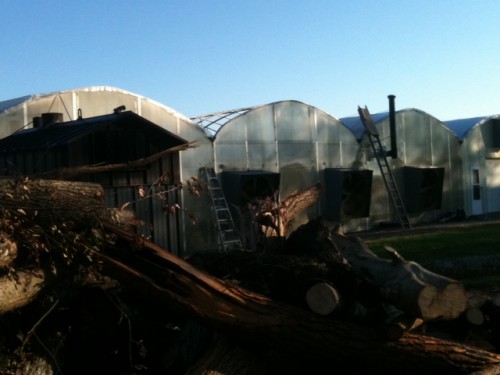
Wondering why we’re changing out the plastic roofs of our three main greenhouses? The benefits are actually twofold. By changing the roofs, with the help of a company like Cap City Restoration, we can help conserve energy. See the picture with the giant stack of wood below? We’ve chopped up some of the large trees that fell across our driveway during Hurricane Irene (We had about 30 trees across our driveway alone!) to use as fuel to heat our greenhouses this winter. To help our wood furnace heat the nursery more efficiently, we’re replacing the plastic that covers our greenhouses. In doing so, we’re adding new, sturdy plastic (similar to https://shrinkwrapcontainments.com/t-panda-premium.aspx) to prevent any holes from leaking heat out. That way it can stay nice and toasty warm inside without being too heavy. Additionally, we’re also creating an area of insulation to hold the heat in (when the summer months come around we will start thinking about getting some greenhouse fans to keep it cool and make sure it has proper airflow. This isn’t such a worry in the winter). We’ve used commercial blowers to fill the space between the inner and outer walls of the greenhouse with air. Once this space is filled it will create a pillow to help make a buffer against the cold and hold the heat in.
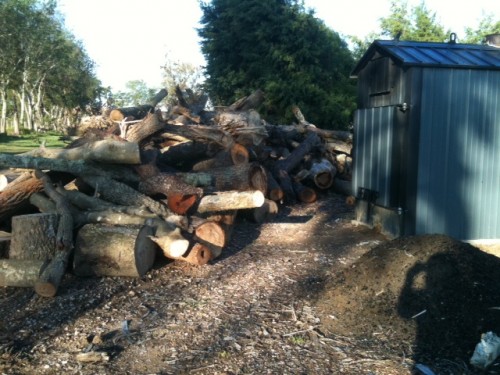
Heat is a huge concern for very obvious reasons. We winter over some of our plants, like Lemon Grass, which loves the heat. It thrives in zones 9-11 where it can get lots of sun. The new plastic and insulated walls will definitely help us to keep more cold-susceptible plants alive throughout the winter, so that we can offer you more mature plants, larger sizes and also have healthy specimen plants to make cuttings from in the Spring.

We’re also replacing the plastic on our roofs so that our plants can get more light. Especially after this past year’s weather (multiple snow storms, hurricanes, floods…even a freak earthquake!), the plastic had started to get pretty dingy. The yellowing of the plastic was filtering the sunlight and preventing more direct rays from getting in to the plants. After finishing one roof already, we can definitely see a huge difference in the amount of light inside the greenhouse. This will help prevent delays in crop availability, as we saw in a few cases this season due to Hurricane Irene and then Tropical Storm Lee. It kinda of gave a new meaning to the phrase, “when it rains, it pours” for us here in zone 7!

This is our newest member of The Growers Exchange, Brandon, helping us prep the roof for new plastic.
by Briscoe White | Sep 16, 2011 | Miscellaneous |
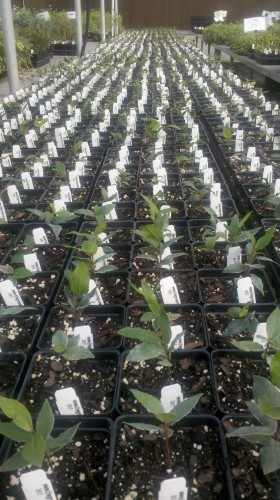
Bays are one of our favorite herbs to grow, as well as one of our most popular products for obvious reasons: It’s a terrific culinary herb that adds a great, savory flavor to your favorite dish, they can be pruned into beautiful topiaries, Bay oil is a natural insect repellent, and the plant can be used medicinally to cure a range of ailments. With all of these things to love about the noble Bay Tree, it’s still hard to be patient with its incredibly difficult germination process and slow growth. To fully appreciate how hard these wonderful plants are to cultivate and how special they are to own, we want to give you a glimpse at the early life cycle of the Bay.
Bays can be germinated from seed or propagated from cuttings. Each method has its own unique challenges, as it is often hard to find a specimen mature enough to take cuttings from and the seeds need meticulous care to germinate. Bay seeds must be obtained fresh and stratified before being sown. The process of stratification forces the plant embryo out of its natural dormancy phase, by simulating cold winter temperatures that would naturally allow the seed’s outer coat to soften and allow the embryo inside to break through. During this process the Bay seeds need to also be kept at a proper moisture level, as when left to dry out, they will not germinate. Once the stratification process is over and they are removed from refrigeration, the seeds need to continue to remain moist and must be sown immediately.
Bay seeds generally have a low germination rate due to their strict needs. Seeds with their pericarp removed (the tough outer seed layers, which are softened by stratification and moisture) only have about a 40% germination rate. In addition to being “needy seeds” and having a low chance of germination, it takes a very long time for the seeds to actually germinate, once planted. Taking roughly about fifty days to germinate, the seeds face a great chance of rotting before they are able to break through the soil. After germination, the plant has a tremendously slow growth rate and can take years to reach just a few feet in height. Grown in areas that mimic the Mediterranean climate that they are native to, like Southern California, the Bay can mature to a tree of twenty feet or more. In most areas though, Bays make a wonderful potted plant and may reach four or five feet high, but even this stature takes quite a while of growth.
Being a gardener means that you must be patient. It can be quite frustrating to put so much love and hard work into seeds that may not come to fruition, but when they do, it is a miraculous joy and triumph over mother nature. We hope that understanding the trials that a seed has to grow through just to get established and large enough to ship to your door, may help us all have patience with a plant like Bay. But believe us, they are more than well worth the wait!











